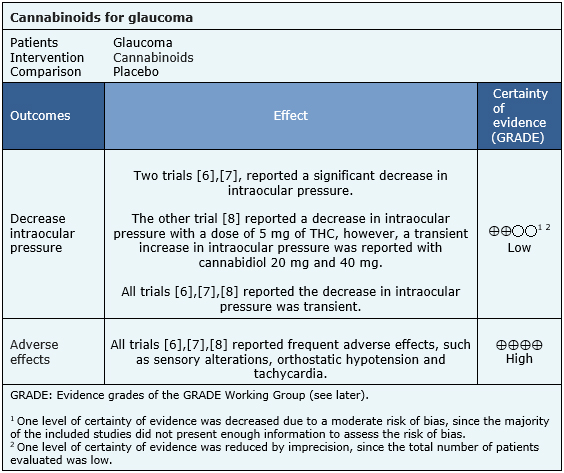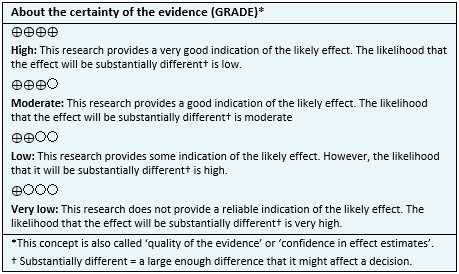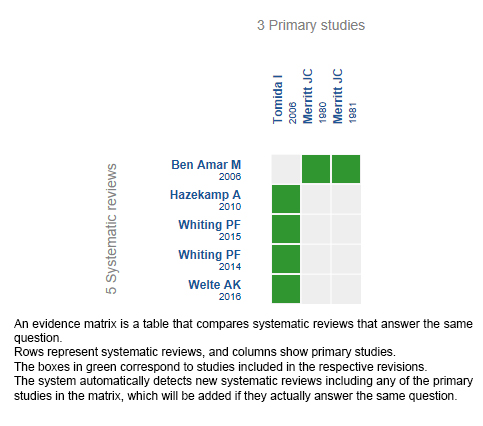Abstract
INTRODUCTION
The use of cannabinoids in diverse clinical conditions is today a subject of debate. Its use has been proposed for the control of glaucoma. However, there is controversy about its real effectiveness and safety.
METHODS
To answer this question we used Epistemonikos, the largest database of systematic reviews in health, which is maintained by screening multiple information sources, including MEDLINE, EMBASE, Cochrane, among others. We extracted data from the systematic reviews, reanalyzed data of primary studies and generated a summary of findings table using the GRADE approach.
RESULTS AND CONCLUSIONS
We identified five systematic reviews including three studies overall, all of them randomized controlled trials. We concluded that although cannabinoids could decrease intraocular pressure, the effect would be transient and associated with frequent adverse effects.
Problem
Glaucoma is a multifactorial optic neuropathy, often related to an increase in intraocular pressure (IOP). The permanently elevated intraocular pressure produces a slow and progressive damage in the optic nerve, generating different sequelae in the visual field and eventually it can lead to irreversible blindness. Although the elevation of intraocular pressure is present in most patients, there is a group of patients who develop glaucoma with normal pressure.
Today there are different medical therapies for the treatment of glaucoma, such as topical betablockers and prostaglandin analogues. The use of cannabinoids has been proposed, since its administration is associated with a decrease in intraocular pressure, through an effect on the production and exit of aqueous humor mediated by the activation of CB1 receptors. Also, neuroprotective properties on the optic nerve have been proposed. However, its actual clinical role is still controversial.
Methods
To answer the question, we used Epistemonikos, the largest database of systematic reviews in health, which is maintained by screening multiple information sources, including MEDLINE, EMBASE, Cochrane, among others, to identify systematic reviews and their included primary studies. We extracted data from the identified reviews and reanalyzed data from primary studies included in those reviews. With this information, we generated a structured summary denominated FRISBEE (Friendly Summary of Body of Evidence using Epistemonikos) using a pre-established format, which includes key messages, a summary of the body of evidence (presented as an evidence matrix in Epistemonikos), meta-analysis of the total of studies when it is possible, a summary of findings table following the GRADE approach and a table of other considerations for decision-making.
|
Key messages
|
About the body of evidence for this question
|
What is the evidence. |
We found five systematic reviews [1],[2],[3],[4],[5] including three primary studies overall [6],[7],[8], all of which correspond to randomized controlled trials. |
|
What types of patients were included* |
All trials included adult patients with glaucoma [6],[7],[8], with average age over 50 years. Only one trial specified the type of glaucoma (primary open-angle glaucoma) [8]. Two trials [7],[8], included patients with intraocular hypertension. |
|
What types of interventions were included* |
One trial [8] used sublingual cannabinoid spray (Sativex®) at doses of 5, 20 and 40 mg. Another trial [6] used smoked marijuana with 2% tetrahydrocannabinol (THC), while the last trial [7] used marijuana in 0.01%, 0.05%, and 0.1% eye drops.All trials compared against placebo or standard treatment. |
|
What types of outcomes |
The different systematic reviews identified [1],[2],[3],[4],[5] grouped the outcomes as follows:
Two trials [7],[8] analyzed the duration of the intraocular pressure decrease, while in the other trial this variable was not reported [6]. |
* The information about primary studies is extracted from the systematic reviews identified, unless otherwise specified.
Summary of Findings
The information on the effects of cannabinoids for glaucoma is based on three randomized trials [6],[7],[8], which include 32 patients in total. All of the trials [6],[7],[8], reported intraocular pressure and adverse effects, and two of them [7],[8] specified the duration of the decrease in intraocular pressure. None of the trials reported decreased visual acuity or visual field deterioration. The summary of findings is the following:
- The use of cannabinoids for glaucoma could be associated with a transient decrease in intraocular pressure, but the certainty of the evidence is low.
- The use of cannabinoids for glaucoma leads to frequent adverse effects. The certainty of the evidence is high.


Other considerations for decision-making
|
To whom this evidence does and does not apply |
|
| About the outcomes included in this summary |
|
| Balance between benefits and risks, and certainty of the evidence |
|
| Resource considerations |
|
| What would patients and their doctors think about this intervention |
|
|
Differences between this summary and other sources |
|
| Could this evidence change in the future? |
|
How we conducted this summary
Using automated and collaborative means, we compiled all the relevant evidence for the question of interest and we present it as a matrix of evidence.

Follow the link to access the interactive version: Cannabinoids for glaucoma
Notes
The upper portion of the matrix of evidence will display a warning of “new evidence” if new systematic reviews are published after the publication of this summary. Even though the project considers the periodical update of these summaries, users are invited to comment in Medwave or to contact the authors through email if they find new evidence and the summary should be updated earlier.
After creating an account in Epistemonikos, users will be able to save the matrixes and to receive automated notifications any time new evidence potentially relevant for the question appears.
This article is part of the Epistemonikos Evidence Synthesis project. It is elaborated with a pre-established methodology, following rigorous methodological standards and internal peer review process. Each of these articles corresponds to a summary, denominated FRISBEE (Friendly Summary of Body of Evidence using Epistemonikos), whose main objective is to synthesize the body of evidence for a specific question, with a friendly format to clinical professionals. Its main resources are based on the evidence matrix of Epistemonikos and analysis of results using GRADE methodology. Further details of the methods for developing this FRISBEE are described here (http://dx.doi.org/10.5867/medwave.2014.06.5997)
Epistemonikos foundation is a non-for-profit organization aiming to bring information closer to health decision-makers with technology. Its main development is Epistemonikos database (www.epistemonikos.org).
Potential conflicts of interest
The authors do not have relevant interests to declare.
 Esta obra de Medwave está bajo una licencia Creative Commons Atribución-NoComercial 3.0 Unported. Esta licencia permite el uso, distribución y reproducción del artículo en cualquier medio, siempre y cuando se otorgue el crédito correspondiente al autor del artículo y al medio en que se publica, en este caso, Medwave.
Esta obra de Medwave está bajo una licencia Creative Commons Atribución-NoComercial 3.0 Unported. Esta licencia permite el uso, distribución y reproducción del artículo en cualquier medio, siempre y cuando se otorgue el crédito correspondiente al autor del artículo y al medio en que se publica, en este caso, Medwave.

INTRODUCCIÓN
El uso de cannabinoides en diversas condiciones clínicas es hoy un tema de debate. Se ha planteado su uso para el control del glaucoma. Sin embargo, existe controversia sobre su real efectividad y seguridad.
MÉTODOS
Para responder esta pregunta utilizamos Epistemonikos, la mayor base de datos de revisiones sistemáticas en salud, la cual es mantenida mediante búsquedas en múltiples fuentes de información, incluyendo MEDLINE, EMBASE, Cochrane, entre otras. Extrajimos los datos desde las revisiones identificadas, reanalizamos los datos de los estudios primarios y preparamos una tabla de resumen de los resultados utilizando el método GRADE.
RESULTADOS Y CONCLUSIONES
Identificamos cinco revisiones sistemáticas que en conjunto incluyen 3 estudios primarios, todos correspondientes a ensayos aleatorizados. Concluimos que, si bien los cannabinoides podrían disminuir la presión intraocular, lo hacen de forma transitoria y se asocian a efectos adversos frecuentes.
 Authors:
Javier Peña[1.2], Camila Jiménez[1,2], Jimena Schmidt[2,3]
Authors:
Javier Peña[1.2], Camila Jiménez[1,2], Jimena Schmidt[2,3]
Affiliation:
[1] Facultad de Medicina, Pontificia Universidad Católica de Chile, Santiago, Chile
[2] Proyecto Epistemonikos, Santiago, Chile
[3] Departamento de Oftalmología, Facultad de Medicina, Pontificia Universidad Católica de Chile, Santiago, Chile
E-mail: jimeschmidt@gmail.com
Author address:
[1] Centro Evidencia UC Pontificia Universidad Católica de Chile Centro de Innovación UC Anacleto Angelini Avda.Vicuña Mackenna 4860 Macul Santiago Chile

Citation: Peña J, Jiménez C, Schmidt J. Do cannabinoids play a role in the control of glaucoma?. Medwave 2018 Ene-Feb;18(1):e7144 doi: 10.5867/medwave.2018.01.7144
Submission date: 23/11/2017
Acceptance date: 29/12/2017
Publication date: 24/1/2018
Origin: This article is a product of the Evidence Synthesis Project of Epistemonikos Fundation, in collaboration with Medwave for its publication.
Type of review: Non-blinded peer review by members of the methodological team of Epistemonikos Evidence Synthesis Project.

Comments (0)
We are pleased to have your comment on one of our articles. Your comment will be published as soon as it is posted. However, Medwave reserves the right to remove it later if the editors consider your comment to be: offensive in some sense, irrelevant, trivial, contains grammatical mistakes, contains political harangues, appears to be advertising, contains data from a particular person or suggests the need for changes in practice in terms of diagnostic, preventive or therapeutic interventions, if that evidence has not previously been published in a peer-reviewed journal.
No comments on this article.
To comment please log in
 Medwave provides HTML and PDF download counts as well as other harvested interaction metrics.
Medwave provides HTML and PDF download counts as well as other harvested interaction metrics. There may be a 48-hour delay for most recent metrics to be posted.

- Ben Amar M. Cannabinoids in medicine: A review of their therapeutic potential. J Ethnopharmacol. 2006 Apr 21;105(1-2):1-25. Review. | PubMed |
- Hazekamp, A, Grotenhermen, F. Review on clinical studies with cannabis and cannabinoids 2005-2009. Cannabinoids. 2010;5(special issue):1-21.
- Whiting P, Wolff R, Westwood M, Duffy S, Misso K, Keurentjes C, Lang S, Harker J, Despande S, Ryder S, Di Nisio M, Hernández AV, Schmidlkofer S, Kleijnen J. Systematic review of cannabis for medical use. Kleijnen Systematic Reviews Ltd. 2014.
- Whiting PF, Wolff RF, Deshpande S, Di Nisio M, Duffy S, Hernandez AV, Keurentjes JC, Lang S, Misso K, Ryder S, Schmidlkofer S, Westwood M, Kleijnen J. Cannabinoids for Medical Use: A Systematic Review and Meta-analysis. JAMA. 2015 Jun 23-30;313(24):2456-73. Erratum in: JAMA. 2016 Apr 12;315(14):1522. JAMA. 2015 Dec 1;314(21):2308. JAMA. 2015 Aug 4;314(5):520. JAMA. 2015 Aug 25;314(8):837. | CrossRef | PubMed |
- Welte AK, Hahn U, Büssing A, Krummenauer F. [Systematic Review of the Application of Complementary and Alternative Medicine and their Potential Therapeutic Benefits in the Treatment of Ophthalmology Patients]. Klin Monbl Augenheilkd. 2017 May;234(5):686-696. | CrossRef | PubMed |
- Merritt JC, Crawford WJ, Alexander PC, Anduze AL, Gelbart SS. Effect of marihuana on intraocular and blood pressure in glaucoma. Ophthalmology. 1980 Mar;87(3):222-8. | PubMed |
- Merritt JC, Olsen JL, Armstrong JR, McKinnon SM. Topical delta 9-tetrahydrocannabinol in hypertensive glaucomas. J Pharm Pharmacol. 1981 Jan;33(1):40-1. | PubMed |
- Tomida I, Azuara-Blanco A, House H, Flint M, Pertwee RG, Robson PJ. Effect of sublingual application of cannabinoids on intraocular pressure: a pilot study. J Glaucoma. 2006 Oct;15(5):349-53. | PubMed |
- Heijl A, Leske MC, Bengtsson B, Hyman L, Bengtsson B, Hussein M; Early Manifest Glaucoma Trial Group. Reduction of intraocular pressure and glaucoma progression: results from the Early Manifest Glaucoma Trial. Arch Ophthalmol. 2002 Oct;120(10):1268-79. | PubMed |
- Buys YM, Rafuse PE. Canadian Ophthalmological Society policy statement on the medical use of marijuana for glaucoma. Can J Ophthalmol. 2010 Aug;45(4):324-6. | CrossRef | PubMed |
- Jampel H. American glaucoma society position statement: marijuana and the treatment of glaucoma. J Glaucoma. 2010 Feb;19(2):75-6. | CrossRef | PubMed |
 Ben Amar M. Cannabinoids in medicine: A review of their therapeutic potential. J Ethnopharmacol. 2006 Apr 21;105(1-2):1-25. Review. | PubMed |
Ben Amar M. Cannabinoids in medicine: A review of their therapeutic potential. J Ethnopharmacol. 2006 Apr 21;105(1-2):1-25. Review. | PubMed | Hazekamp, A, Grotenhermen, F. Review on clinical studies with cannabis and cannabinoids 2005-2009. Cannabinoids. 2010;5(special issue):1-21.
Hazekamp, A, Grotenhermen, F. Review on clinical studies with cannabis and cannabinoids 2005-2009. Cannabinoids. 2010;5(special issue):1-21.  Whiting P, Wolff R, Westwood M, Duffy S, Misso K, Keurentjes C, Lang S, Harker J, Despande S, Ryder S, Di Nisio M, Hernández AV, Schmidlkofer S, Kleijnen J. Systematic review of cannabis for medical use. Kleijnen Systematic Reviews Ltd. 2014.
Whiting P, Wolff R, Westwood M, Duffy S, Misso K, Keurentjes C, Lang S, Harker J, Despande S, Ryder S, Di Nisio M, Hernández AV, Schmidlkofer S, Kleijnen J. Systematic review of cannabis for medical use. Kleijnen Systematic Reviews Ltd. 2014.  Whiting PF, Wolff RF, Deshpande S, Di Nisio M, Duffy S, Hernandez AV, Keurentjes JC, Lang S, Misso K, Ryder S, Schmidlkofer S, Westwood M, Kleijnen J. Cannabinoids for Medical Use: A Systematic Review and Meta-analysis. JAMA. 2015 Jun 23-30;313(24):2456-73. Erratum in: JAMA. 2016 Apr 12;315(14):1522. JAMA. 2015 Dec 1;314(21):2308. JAMA. 2015 Aug 4;314(5):520. JAMA. 2015 Aug 25;314(8):837. | CrossRef | PubMed |
Whiting PF, Wolff RF, Deshpande S, Di Nisio M, Duffy S, Hernandez AV, Keurentjes JC, Lang S, Misso K, Ryder S, Schmidlkofer S, Westwood M, Kleijnen J. Cannabinoids for Medical Use: A Systematic Review and Meta-analysis. JAMA. 2015 Jun 23-30;313(24):2456-73. Erratum in: JAMA. 2016 Apr 12;315(14):1522. JAMA. 2015 Dec 1;314(21):2308. JAMA. 2015 Aug 4;314(5):520. JAMA. 2015 Aug 25;314(8):837. | CrossRef | PubMed | Welte AK, Hahn U, Büssing A, Krummenauer F. [Systematic Review of the Application of Complementary and Alternative Medicine and their Potential Therapeutic Benefits in the Treatment of Ophthalmology Patients]. Klin Monbl Augenheilkd. 2017 May;234(5):686-696. | CrossRef | PubMed |
Welte AK, Hahn U, Büssing A, Krummenauer F. [Systematic Review of the Application of Complementary and Alternative Medicine and their Potential Therapeutic Benefits in the Treatment of Ophthalmology Patients]. Klin Monbl Augenheilkd. 2017 May;234(5):686-696. | CrossRef | PubMed | Merritt JC, Crawford WJ, Alexander PC, Anduze AL, Gelbart SS. Effect of marihuana on intraocular and blood pressure in glaucoma. Ophthalmology. 1980 Mar;87(3):222-8. | PubMed |
Merritt JC, Crawford WJ, Alexander PC, Anduze AL, Gelbart SS. Effect of marihuana on intraocular and blood pressure in glaucoma. Ophthalmology. 1980 Mar;87(3):222-8. | PubMed | Merritt JC, Olsen JL, Armstrong JR, McKinnon SM. Topical delta 9-tetrahydrocannabinol in hypertensive glaucomas. J Pharm Pharmacol. 1981 Jan;33(1):40-1. | PubMed |
Merritt JC, Olsen JL, Armstrong JR, McKinnon SM. Topical delta 9-tetrahydrocannabinol in hypertensive glaucomas. J Pharm Pharmacol. 1981 Jan;33(1):40-1. | PubMed | Tomida I, Azuara-Blanco A, House H, Flint M, Pertwee RG, Robson PJ. Effect of sublingual application of cannabinoids on intraocular pressure: a pilot study. J Glaucoma. 2006 Oct;15(5):349-53. | PubMed |
Tomida I, Azuara-Blanco A, House H, Flint M, Pertwee RG, Robson PJ. Effect of sublingual application of cannabinoids on intraocular pressure: a pilot study. J Glaucoma. 2006 Oct;15(5):349-53. | PubMed | Heijl A, Leske MC, Bengtsson B, Hyman L, Bengtsson B, Hussein M; Early Manifest Glaucoma Trial Group. Reduction of intraocular pressure and glaucoma progression: results from the Early Manifest Glaucoma Trial. Arch Ophthalmol. 2002 Oct;120(10):1268-79. | PubMed |
Heijl A, Leske MC, Bengtsson B, Hyman L, Bengtsson B, Hussein M; Early Manifest Glaucoma Trial Group. Reduction of intraocular pressure and glaucoma progression: results from the Early Manifest Glaucoma Trial. Arch Ophthalmol. 2002 Oct;120(10):1268-79. | PubMed |Systematization of initiatives in sexual and reproductive health about good practices criteria in response to the COVID-19 pandemic in primary health care in Chile
Clinical, psychological, social, and family characterization of suicidal behavior in Chilean adolescents: a multiple correspondence analysis








